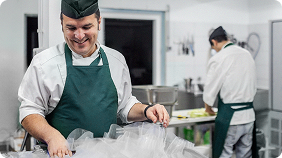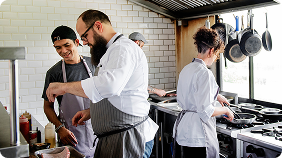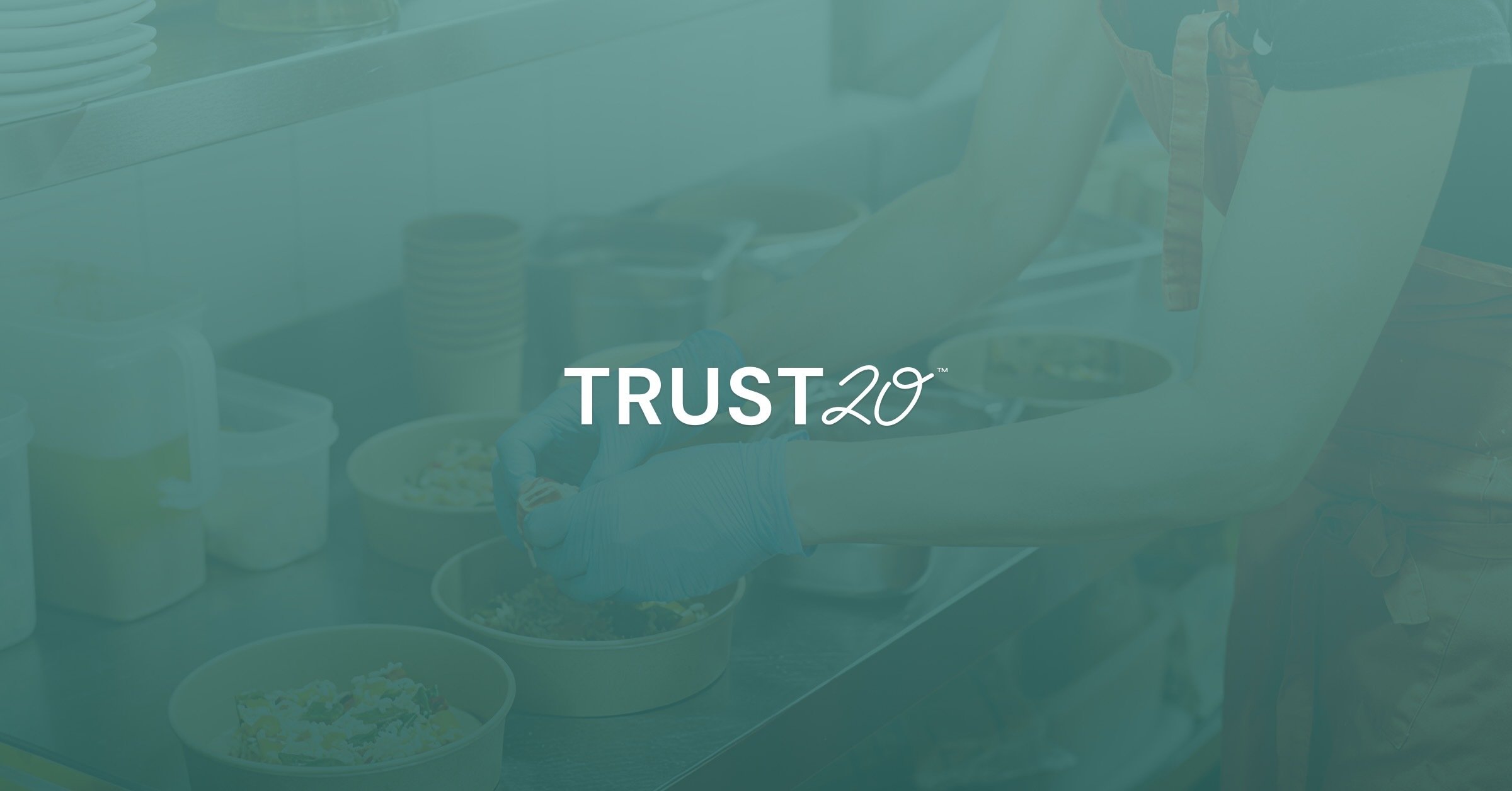Artificial intelligence (AI) is everywhere these days. AI is already making many industries more efficient and effective, and the food industry–particularly food safety–is no exception.
Studies have shown artificial intelligence can identify bacteria in food, making it a powerful tool in the fight against foodborne illnesses.1 So, as AI technologies evolve, it makes sense to consider how they can support your work in the food industry, especially your food safety and training efforts.
Read on to learn how AI can support and transform the food industry–and how you can leverage its benefits without dealing with potential pitfalls.
In this article, we’ll cover:
The future of AI in the food industry
Addressing common concerns about AI
Tips for incorporating AI into your foodservice business
What to expect from AI in the food industry
Food safety training today
For years, in-person lectures, instructional videos, and stand-up meetings have been the standard for food safety training. Food safety training is non-negotiable, and unfortunately, it generally fills operators and staff with a sense of dread.
On the plus side, in-person training allows staff to ask real-time questions and fosters a sense of community on a team. However, long lectures and monotonous videos make it difficult for people to stay engaged and retain information.
Many conventional training programs also use outdated presentations or handouts that do not account for evolving regulations or industry best practices.
However, artificial intelligence is poised to bring about some of the most meaningful changes to food safety since Abraham Lincoln formed the USDA more than 150 years ago.
The future of AI in the food industry
The food industry is already using AI to mitigate many food safety risks.
Manufacturers and suppliers use blockchain technology to trace the farm-to-table product journey to identify potential threats, predictive analytics to prevent outbreaks, and smart sensors to monitor storage conditions.2
As food handlers are often one of the greatest threats to food safety, it makes sense that AI will play a more significant role in the training process.
Read on for examples of where and how we expect the food industry to integrate AI into food safety and training over the next few years.
Immersive simulation training
Immersive simulation technologies, like Virtual Reality (VR) and Augmented Reality (AR), are used in other industries to create interactive, hands-on experiences that improve learning outcomes.
The beauty of immersive simulation training is that participants can engage in hands-on practice without the risks or constraints of the real world.
Verizon is one company that has adopted StriVR’s VR training platform, and its realistic scenarios that mimic the potential hazards of their day-to-day work have remarkably improved the outcomes of their safety training program.3
One day soon, VR and AR will also create highly realistic scenarios for the food industry, allowing staff to practice how they would respond to situations like a customer having an allergic reaction, a health inspection, or an incorrect order from a food supplier.
While this type of immersive technology is not yet widely available, operators can (and should!) seek out online training programs that heavily feature interactive elements such as knowledge checks and decision-making scenarios to enhance the retention and application of critical food safety information.
Customized learning
Traditional training methods tend to fail to address individual skill levels, learning styles, and knowledge gaps. No two team members are exactly alike, and AI can take that into account.
Paradox.ai is one example of software that streamlines administrative tasks and personalizes user experiences. Initially designed for hiring, Paradox.ai uses conversational AI to engage with users, gather information, and tailor interactions based on individual preferences.
In the context of food safety training, the industry could use similar software to create customized learning experiences that identify knowledge gaps, provide real-time feedback, and recommend certain modules, quizzes, or scenarios based on each person’s unique strengths and weaknesses.
Real-time monitoring
Food safety regulations and best practices are constantly changing. Since AI can quickly process a lot of data, it can help you and your team stay up-to-date on the latest guidelines.
Technologists at Casetext, Inc., a legal AI company, have built integrations that track and communicate the latest case law and regulatory changes to their users.
The food industry can replicate this by using AI to monitor regulatory changes in food safety through real-time scans of regulatory websites, industry publications, and government updates. Reports from this kind of tracking will give you time-sensitive updates and help you maintain accurate training materials over time.
AI can also help you analyze the success of your food safety training and use performance metrics, learner feedback, and assessment results to identify trends, patterns, and opportunities for improvement in your program.
A data-driven approach guarantees your food safety training remains effective, relevant, and aligned with changing industry standards.
Addressing common concerns about AI
Are you excited about AI? Are you still on the fence? Let’s look at some common concerns about artificial intelligence–and why you shouldn’t worry.
AI will take over jobs
As AI continues to filter into the world, one common concern is the potential for artificial intelligence to replace human jobs. However, AI is meant to augment or enhance our human capabilities.
When you consider AI's efficiency, the fear seems valid. However, you should use AI as a collaborative tool. Its true strength lies in its capacity to help us analyze data, identify patterns, and provide insights that facilitate informed decision-making.
Let’s look at it in the context of another technological advancement: email.
Many people feared that email would replace clerical jobs and other communication roles. However, email simply transformed communication practices and ultimately created new roles and opportunities in the digital space.
Similarly, AI has the potential to revolutionize processes, create new job functions, and elevate the quality of our work.
AI is too expensive
While the initial investment may be intimidating, AI’s value over time tends to outweigh the upfront cost. Instead of thinking about the immediate cost, consider the potential return on your investment.
Long-term benefits, like optimized processes, improved compliance, enhanced decision-making, and risk management, will ultimately increase your team’s productivity and save you money over time. AI can also be tailored and scaled to accommodate your establishment's specific challenges and needs.
The food industry routinely uses other technologies to reduce costs and increase revenue, and AI can do the same.
AI will steal my data
Data security and privacy concerns are valid. However, responsible technology practices will keep you, your data, and your customers’ data safe.
Start by familiarizing yourself with data protection regulations, and ensure any AI software you use has transparent data security policies.4
Your digital records should have robust data encryption to safeguard sensitive information, and you should anonymize personal data to protect individual privacy and prevent unauthorized access or misuse.
Are you interested in using AI, but data security sounds overwhelming? Consider partnering with a data security consultant to ensure you follow the law and implement the proper safeguards.
AI lacks specificity
The truth is that AI is a blunt instrument unless you customize it to suit a specific need. To be effective, an AI algorithm must be tailored to fit into your business.
Before using any AI tool, clarify your establishment's unique food safety goals, objectives, and key performance indicators (KPIs) to guide your training and development initiatives.
You can work closely with AI developers or utilize a configurable AI platform to ensure the technology can meet your establishment's unique needs.
Tips for incorporating AI into your foodservice business
Ready to bring AI into your business? Here are four ways to get the process started.
-
Educate yourself: Stay on top of evolving regulations and technological advancements in the food industry to guarantee you stay in compliance while using AI.
-
Start small: Test AI on a small scale, focusing on specific administrative tasks or training modules to assess feasibility and demonstrate value before you start scaling up.
-
Optimize experiences: Set up AI to analyze customer preferences, behaviors, and feedback, then use the information to improve your customer service experience.
-
Embrace automation: Implement AI-driven inventory management systems to help predict demand, optimize product levels, reduce waste, and align your food supplies with use patterns.
Whenever you implement a new technology in your business, encourage your team to provide feedback on any tools, training programs, and operational workflows they interact with. Team feedback will help you identify areas for improvement, address concerns, and build a culture of continuous improvement.
What to expect from AI in the food industry
Artificial intelligence presents a transformative opportunity for food safety and training.
Establishments can leverage AI to stay ahead of food safety risks, provide tailored and engaging training experiences, and ensure compliance with changing regulations. Integrating AI into the food industry promises increased efficiency and effectiveness and fosters a proactive approach to food safety.
By starting small and scaling thoughtfully, you can use AI to create safer, more efficient environments for your customers and staff.
The future of food safety is bright, and the possibilities of AI can help make it shine.
Sources:
- UC Davis: How Artificial Intelligence May Improve Food Safety
- S&P Global Market Intelligence: Companies use blockchain to track food products from farm to fork
- StriVR: Verizon protects & empowers retail associates with immersive learning
- Forbes: U.S. Data Privacy Protection Laws: A Comprehensive Guide
- Food and Drug Administration: Food Safety Modernization Act (FSMA) | FDA






.png)

.png)
